Bottlebrush copolymers, also referred to as molecular brushes or cylindrical polymer brushes, are comb-like macromolecules with polymeric side chains (bristles) densely grafted along the polymeric backbone where the spacing between the side chains is small enough so that they can “feel” each other (L < 2Rg). Typically, bottlebrush copolymers contain bristles emanating from every repeat unit of the backbone. Excluded volume interactions between such densely grafted side chains force the backbone to adopt an extended conformation. This molecular arrangement results in a number of unique properties that are characteristic to bottlebrush copolymers.
1. Rigid: Bottlebrush copolymers exhibit an increased persistence length (characteristic of molecular rigidity) due to the diminished conformational freedom of the backbone. Thus, rigid molecules can be prepared from repeat units that are inherently flexible, solely due to the polymer architecture.
2. Cylindrical: Densely grafted bristles along the extended backbone result in a persistent cylindrical shape in solution. In contrast to cylindrical polymer micelles, which also provide access to the same shape factor by solution self-assembly of linear block copolymers with certain compositions, single-component bottlebrush copolymers can produce robust, covalently connected cylindrical particles with predetermined lengths without the need for self-assembly or the presence of two incompatible segments.
Research
Our research program embraces all the steps of a successful materials design, from building tailored polymer structures and architectures to analyzing their supramolecular organization to testing their macroscale properties. We synthesize complex macromolecular architectures and study how these molecules come together to form a solid state material or discrete assemblies in solution. Over the years, we have developed extensive synthetic expertise that allows us to push the limits of what is achievable in terms of creating multicomponent macromolecules with well-defined dimensions, shapes and compositions. We are using these macromolecules as building blocks to create nanostructured materials to benefit a variety of applications where nanoscale domains play a critical role in dictating the function of the material. At the same time, recognizing a major societal challenge, we are developing chemistry tools to convert commodity plastic waste into valuable materials. Our group's fundamental research in synthetic chemistry, molecular design and assembly helps global efforts in developing nanostructured materials for filtration, water purification, and energy storage, as well as polymer upcycling. A number of established collaborative efforts have helped us to enhance our structural characterization capabilities and develop materials for functional applications.
1) Nanoscale networks. Polymers with continous interconnected channels that span across the material allow for selective transport modulated by the nanoscale dimensions of the domains and are of interest in a variety of applications, such as molecular separations and energy generation and storage. We are designing new methods for the fabrication of polymeric materials with percolating network domains by covalent assembly of molecularly engineered bottlebrush copolymer building blocks that are used both as rigid network interconnectors and porogens (precursors to pores). We are striving to achieve molecular control of the materials properties, developing structure-property relationships, and integrating these methods for materials fabrication into emerging additive manufacturing technologies.
2) Polymer upcycling. Polymers have become victims of their own success. The same properties that have led to their widespread use are now hindering their recycling and result in accumulation of plastic waste in landfills, which poses an ever increasing environmental and societal challenge. We are tackling this challenge by developing new chemical methods for upcyling of polyethylene, one of the most widely used and most chemically inert commodity plastics. Controlled break down of polyethylene chains produces reactive building blocks for the construction of new functional materials.
3) Bottlebrush copolymer self-assembly. Polymer self-assembly is a powerful way of constructing nanostructured materials. The fundamental question we are trying to address in this research is as following: can polymer architecture and shape be used to control the way molecules assemble, and therefore the structure and the properties of the material they are forming? This research involves the synthesis of bottlebrush copolymers with controlled sequence of blocks and strategically placed components to assess the effect of such structural and architectural modifications on the assembly process, with the goal of not only controlling the nature of forming nanoscale domains but also their orientation on surfaces.
Described below are selected examples of research areas where our group has made pioneering or significant contributions and maintain strong interest and presence. These are not intended as a comprehensive overview of our research program, but rather as an introduction to the field of bottlebrush copolymers, with particular emphasis on research from our group. This is a growing field with many exciting contributions coming from researchers across the world, beautifully summarized in numerous recent revew articles.
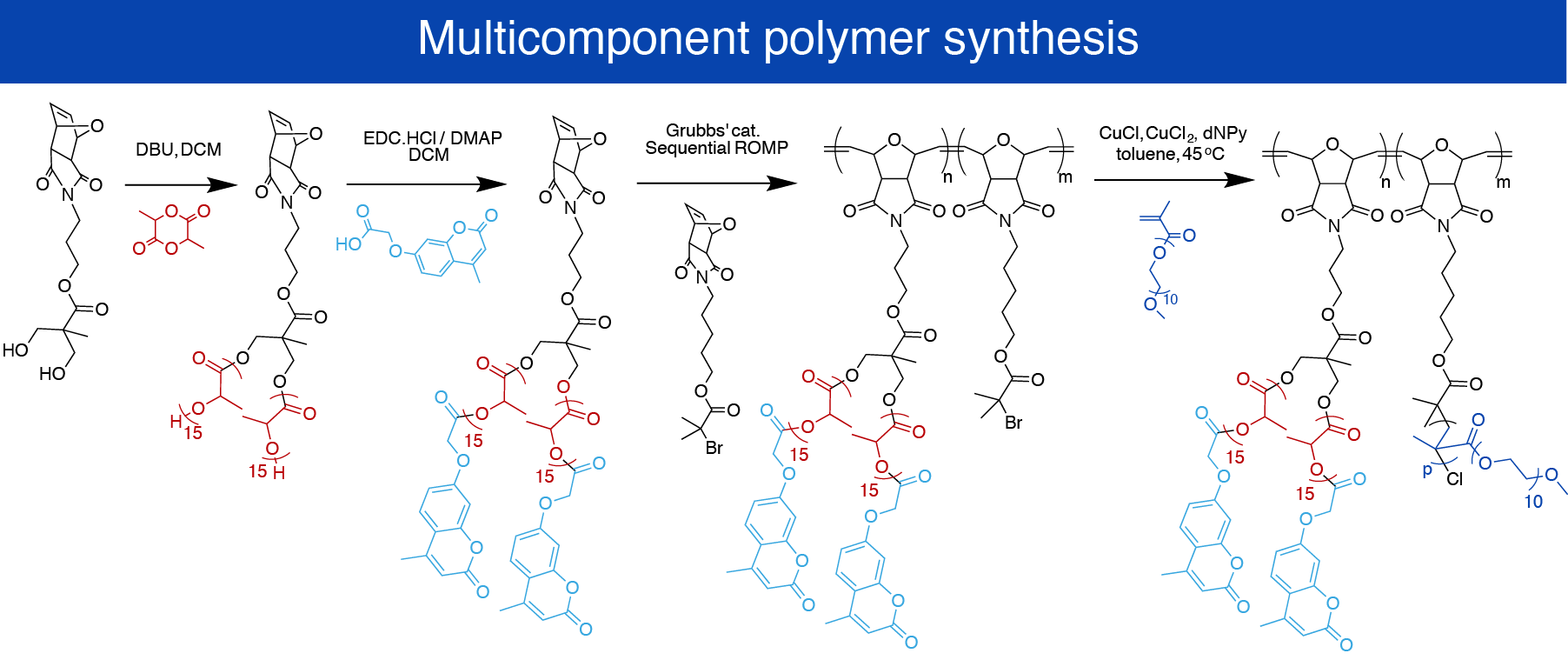
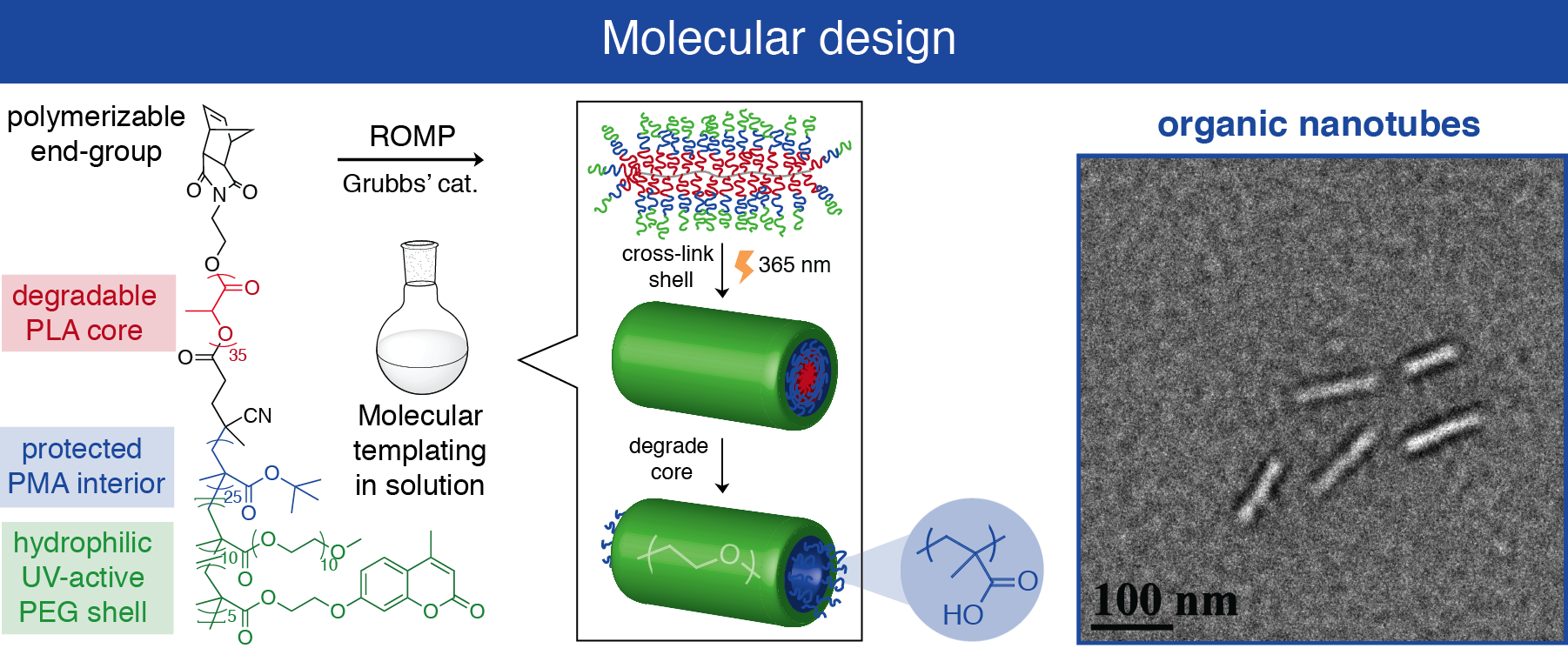
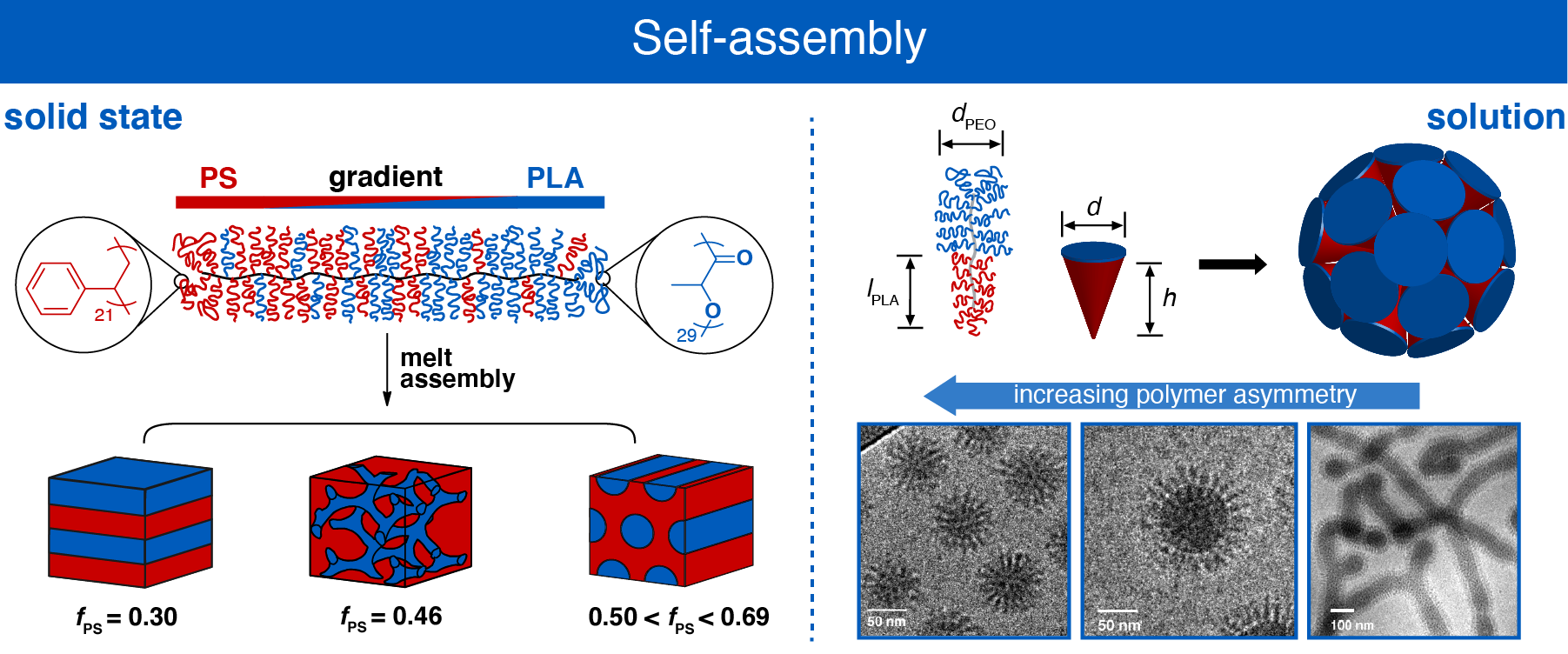
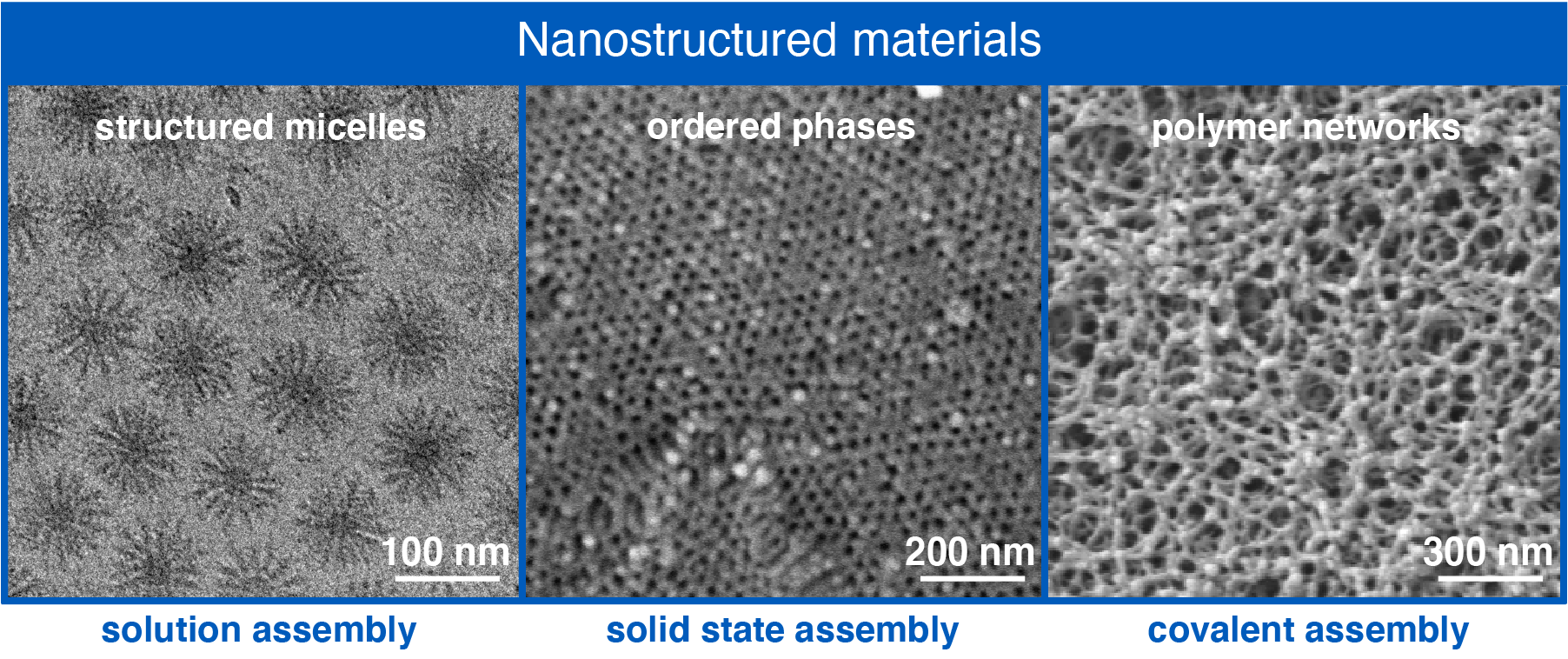
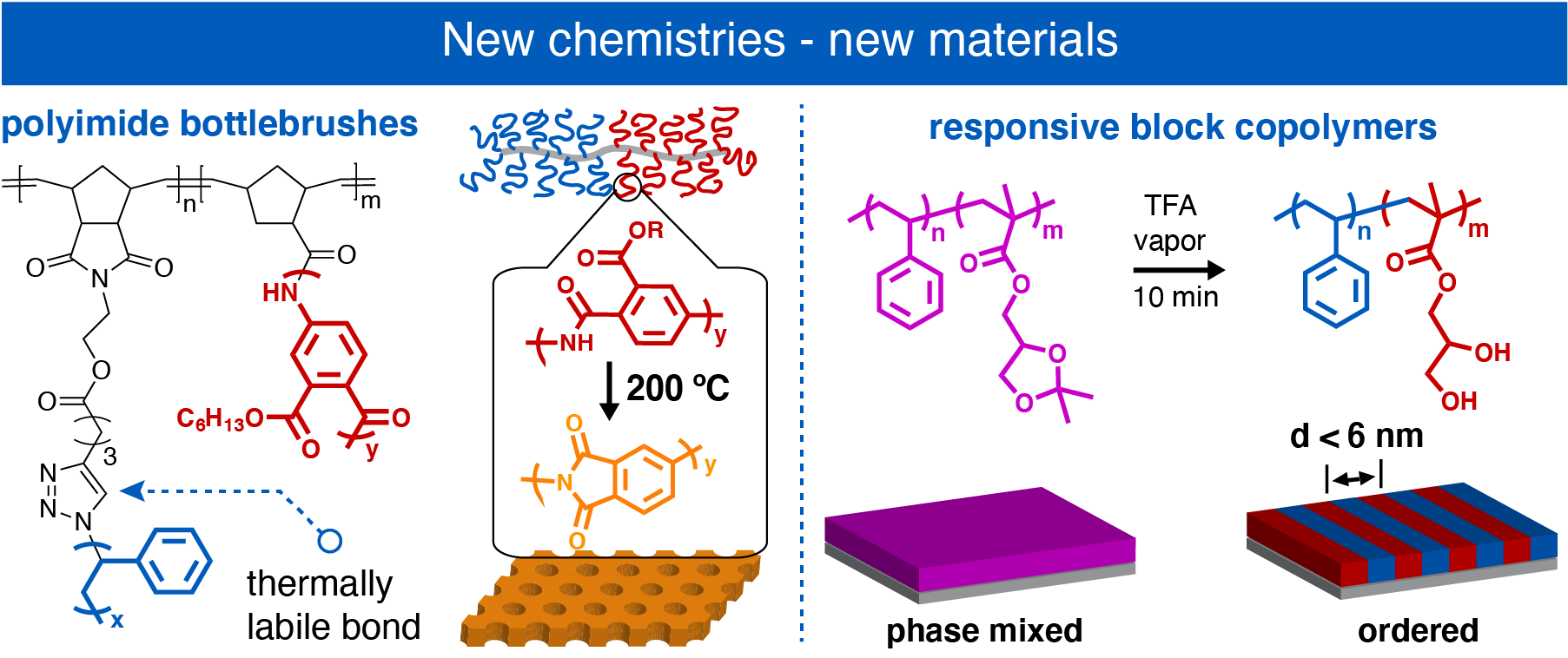
Bottlebrush Copolymers
3. Unentangled: Molecular rigidity in combination with short side chains, which are typically used for the preparation of bottlebrush copolymers, decrease the density of chain entanglements in the solid state, as compared to their linear copolymer analogs. While this is not advantageous for mechanical properties, the lack of entanglements aids the molecular mobility and allows for efficient and rapid self-assembly of bottlebrush copolymers in the solid state despite their enormous sizes.
4. Tunable: Tremendous progress in synthetic polymer chemistry in the last two decades has facilitated access to multicomponent bottlebrush copolymers where the components can be distributed in blocky, statistical, Janus, core-shell or gradient arrangements. This affords an exquisite tunability of the bottlebrush copolymer structure, dimensions and segmental interactions.
It is clear from the discussion above that bottlebrush copolymers present a highly attractive platform for rational molecular design and fabrication of nanostructured materials by solution and solid state assembly, as well as molecular templating, avenues that we have been pursuing in our group since 2006. Despite the explosive growth in this field of research in the last decade, there remain a multitude of exciting avenues to pursue and a number of important challenges to tackle.
Molecular Templating
Organic tubular structures of nanometer dimensions are versatile platforms for a wide array of applications, such as selective ion transport, chemical catalysis, biosensors and nanocomposites. We reported a new method for the fabrication of organic nanotubes by molecular templating of core-shell bottlebrush copolymers (DOI: 10.1021/ja901936g). Core-shell bottlebrush copolymers are transformed into nanotubes by intramolecular cross-linking of the exterior layer (shell), and selective etching of the polyester core. This strategy allows one to control the structural characteristics (length and pore size) and functional composition (exterior and interior) of the prepared nanotubes in an unprecedented fashion. The dimensions of tubular structures prepared by this method replicate those of the precursor bottlebrush copolymers. Unlike strategies that rely on solid templates for the preparation of controlled length nanotubes, this molecular templating strategy is performed in solution and is not limited by the surface area of the template.
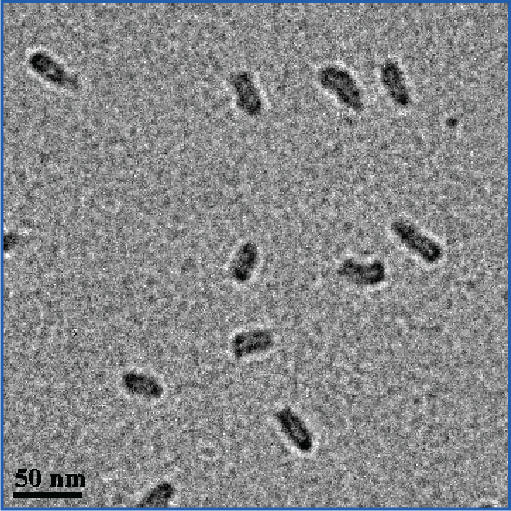
TEM analysis of organic nanotubes
Periodic Nanostructures by Solid-State Assembly
Block polymer self-assembly is a powerful tool for creating materials with periodic nanostructures, which are useful for a variety of applications. Linear block polymers can provide nanostructures with domain spacings of up to 100 nm. Attaining larger periodicities is much more challenging due to the difficulties associated with the synthesis and slow self-assembly kinetics of very long (and highly entangled) linear polymers. We have shown that bottlebrush block polymers, unlike their linear analogs, are able to organize into highly ordered nanostructures with domain spacings over 200 nm that exhibit photonic properties. DOI: 10.1021/ma802304y
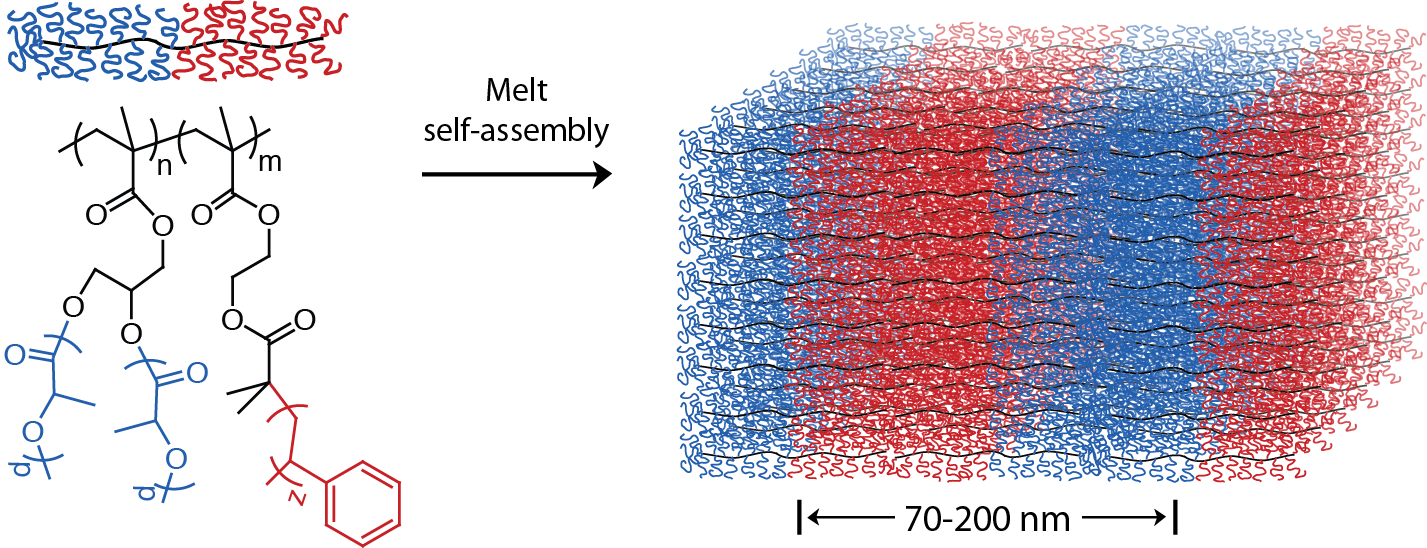
In this research, we study how molecular bottlebrushes come together in the solid state to form a nanostructured material. We manipulate various structural characteristics, such as side chain length and asymmetry, backbone length and asymmetry, side chain distribution along the backbone, and chemical identity of the backbone and end groups to control the macromolecular packing in the solid state. Due to their rigid nature, bottlebrush copolymers favor packing into lamellar microstructures (flat interfaces). We have shown that by using asymmetric side chains to alter the shape of the bottlerbush copolymers one can favor the formation of microstructures with curved interfaces, such as in the cylindrical morphology. Selective removal of the cylinderical phase can then result in nanoporous materials with large pores that are difficult to access from linear block coplymers. DOI: 10.1021/nl103747m.
All of these structural manipulations require extensive synthetic efforts and development of new protocols for the preparation of complex multicomponent bottlebrush copolymers. For example, we recently developed a new method for the synthsis of bottlebrush copolymers with a gradient compositional profile by one-pot polymerization of exo- and endo-norbornene functionalized macromonomers. These gradient bottlebrush copolymers exhibited a rich morphological behavior as compared to their block copolymer analogs, as evidenced by a wide cylindrical morphology window and the observation of the elusive bicontinuous gyroid morphology. DOI: 10.1021/acs.macromol.9b01756
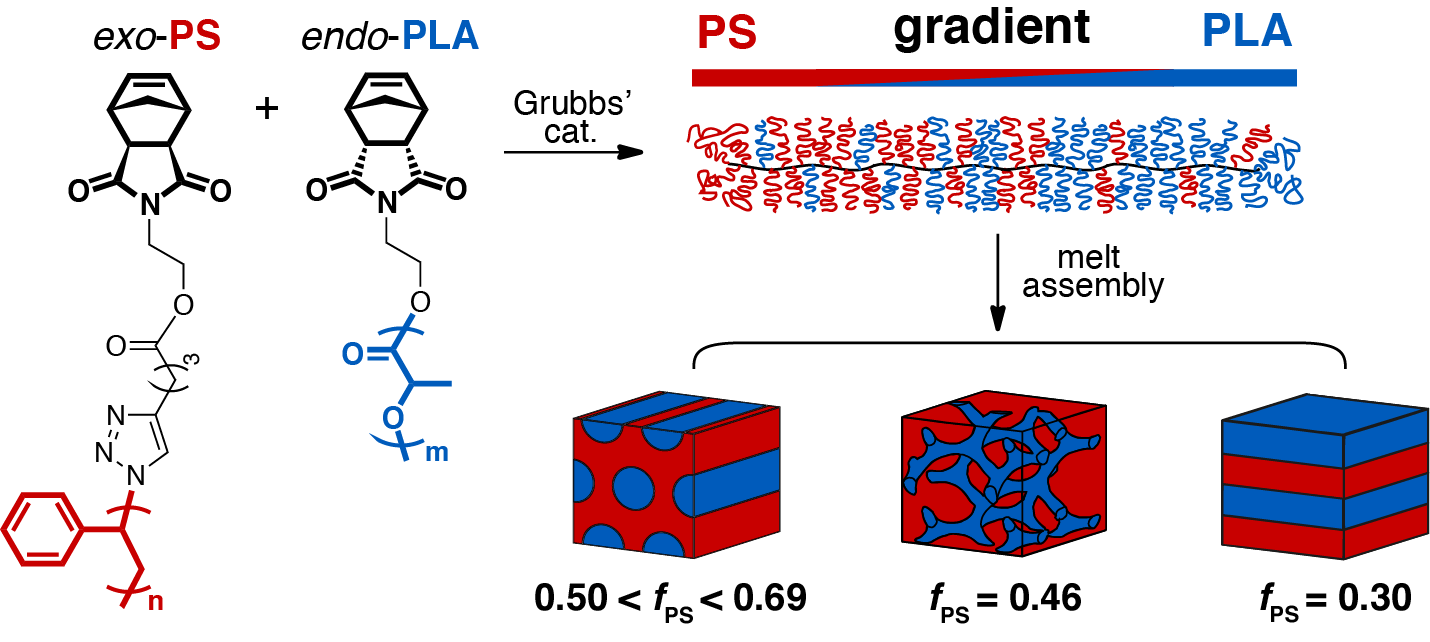
Discrete Nanostructures by Solution Assembly
Amphiphilic block copolymers, composed of covalently connected hydrophilic and hydrophobic polymer chains, have found widespread use in a variety of applications as surfactants, emulsifiers, rheological modifiers, structure directing agents and drug delivery vehicles due to their ability to self-assemble at interfaces and form micellar aggregates in solution. We are interested in understanding how bottlebrush copolymers with hydrophilic and hydrophobic components organize in aqueous solutions to produce highly stable and uniform aggregates, one dimensional assemblies and multicompartment nanostructures. In this research, we employed bottlebrush copolymers as a platform for building blocks with directional interactions to achieve biomimetic assembly. We have shown that molecular shape can be used to control the interfacial curvature and aggregate morphology during amphiphilic bottlebrush copolymer assembly in solution.

Aqueous assembly of bottlebrush copolymers with hydrophilic, biodegradable polylactic acid (PLA) side chains and hydrophilic, bioinert polyethylene oxide (PEO) side chains produces uniform aggregates with extremely low critical micelle concentrations, desirable for biological applications. By tuning the length of the side chains, which defines the molecular shape, we produced uniform spherical micelles, worm-like cylindrical micelles, and bilayer structures. DOI: 10.1021/ja503283r Amphiphilic bottlebrush copolymers with coumarin-functionalized PLA side chains exhibited excellent paclitaxel uptake capacities, and upon photo-irradiation can be covalently cross-linked into biodegradable PLA nanoparticles. DOI: 10.1021/acs.macromol.6b02182 The use of multiblock and gradient amphiphilc bottlebrush copolymers has allowed us to refine the control of micelle formaion.
Polymer Networks
Polymeric materials with continuous nanoscale network domains are desirable in many applications that rely on transport of molecules, ions and electrons across the sample, such as separations, membranes for fuels cells, solar cells, and batteries. In addition to possessing interconnected nanoscale domains, other materials properties, such as chemical and thermal stability of the matrix, pore uniformity and surface chemistry, play an important role in choosing the correct materials design platform for the above mentioned applications. In addition to pursuing polymer self-assembly approaches to generate the elusive, highly ordered network morphologies, we work on developing new approaches to network fabrication by taking advantage of the cylindrical shape and nanometer length scale of bottlebrush copolymers. We are particularly interested in fabricating nanoporous membranes for water purification, and nanostructured membranes for energy storage applications.
Inspired by metal organic framework and covalent organic framework approaches, which use small molecule rigid building blocks to generate porous materials, we have developed a new method for the fabrication of nanoporous polymers by using end-reactive bottlebrush copolymers as network interconnectors. Two orthogonally reactive groups are used for network formation and intramolecular bottlebrush strand cross-linking to produce a rigid framework that is able to withstand solvent evaporation to result in nanoporus materials. The produced mesoporous polymer frameworks are characterized by uniform and tunable pore dimensions that are controlled by the length of the bottlebrush strands. DOI: 10.1021/acsnano.7b03214
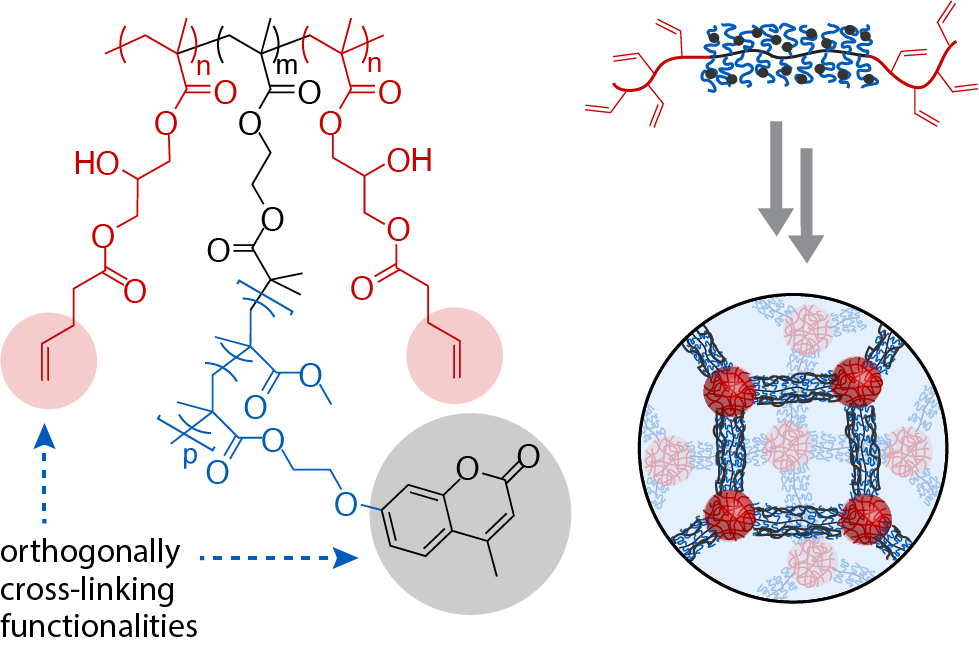
In this research, we are continuing to develop a number of different approaches based on end-reactive and peripherally reactive bottlebrush copolymers, side chain asymmetric bottlebrush copolymers, and ultrahigh molecular weight linear block copolymers for the preparation of polymer networks, nanoporous plastics, and ultrathin water filtration membranes.
